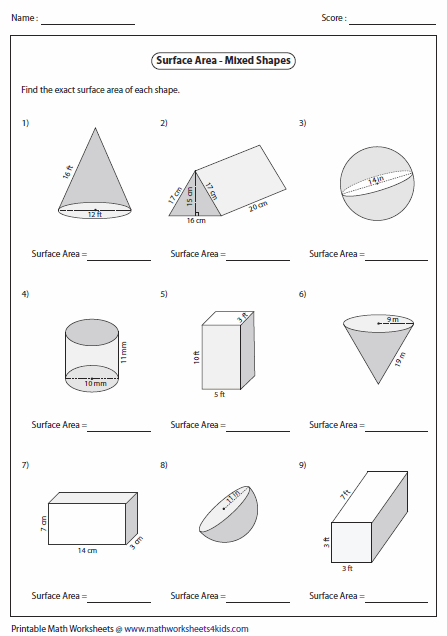Remember that awkward moment in geometry class when the teacher presented a shape that wasn’t a simple square or circle? You knew the basics of calculating area, but the combined shapes threw you for a loop. It felt like navigating a maze without a map! The good news is, understanding how to find the surface area of mixed shapes is essential for success in math and real-world applications. Think about designing a building, figuring out how much paint to buy, or even creating a custom-shaped cake – these are all situations that involve mixed shapes and their surface areas.

Image: www.mathworksheets4kids.com
This article is your guide to conquering the complexities of mixed shapes. From understanding the fundamental concepts to mastering the techniques for solving diverse problems, we’ll break down everything you need to know. By the end, you’ll be confidently calculating the surface area of any mixed shape, no matter how intricate it might seem.
Unlocking the Mysteries of Mixed Shapes
Let’s start with the basics. Surface area is the total area covered by all the faces of a three-dimensional object. Think of it like wrapping a present – the amount of wrapping paper you need represents the surface area. For simple shapes like cubes and spheres, the surface area formulas are straightforward. However, things get interesting when we encounter a combination of different shapes, like a cone attached to a cylinder or a pyramid resting on top of a rectangular prism.
The key to tackling mixed shapes is to break them down into their individual components. Visualize each shape separately, calculate its surface area using the appropriate formula, and then add up the individual surface areas to find the total surface area of the mixed shape. Sounds simple, right? But, like any intriguing puzzle, the real challenge lies in applying this strategy to different scenarios.
Decoding the Calculations: A Step-by-Step Approach
Imagine you’re tasked with finding the surface area of a box with a triangular prism attached to the top. Here’s how to approach the problem step-by-step:
- **Identify the Shapes:** First, recognize that the object consists of two distinct shapes: a rectangular prism (the box) and a triangular prism (the top attachment).
- **Calculate Individual Surface Areas:** For the rectangular prism, use the formula 2lw + 2wh + 2lh (where l = length, w = width, and h = height). For the triangular prism, find the area of each triangular face (1/2 * base * height) and multiply by 2 (since there are two identical triangles). Then, calculate the area of the rectangular faces (length of base * height of triangle) and multiply by the number of rectangles.
- **Combine the Areas:** Add the surface area of the rectangular prism to the surface area of the triangular prism. This will give you the total surface area of the combined shape.
Solving Real-World Dilemmas: From Design to Decoration
Understanding surface area isn’t just a theoretical exercise; it’s a practical skill with real-world applications. In architecture and engineering, architects calculate the surface area of buildings to determine the amount of materials needed. In construction, workers use surface area calculations to figure out how much paint or wallpaper to buy.
Even everyday tasks can involve surface area considerations. Ever wondered how much fabric you need to cover a table or how much wrapping paper you need for a gift box? Knowing how to calculate surface area can save you time, money, and even prevent you from running out of materials in the middle of a project!

Image: www.formsbank.com
Tips and Expert Advice for Mastering Mixed Shapes
Here are some valuable tips to help you master the art of calculating surface area for mixed shapes:
- Break it Down: Always begin by identifying the individual shapes that make up the mixed shape.
- Visualize: Try sketching or creating a model of the shape to help you visualize it better.
- Label: Label each shape and its dimensions to avoid confusion and make calculations more organized.
- Use Appropriate Formulas: Be sure to use the correct formulas for each shape. Don’t assume shapes are simple. For example, a box may have an irregular top.
- Practice Regularly: Like any skill, mastering surface area requires practice. Work through different examples and challenge yourself with increasing complexity.
FAQ: Surface Area of Mixed Shapes
Q: How do I handle overlapping surfaces?
A: When calculating surface area, you only count the exposed surfaces once. For example, if two shapes share a surface, you don’t add that shared surface twice. Only count it if it is an exterior surface.
Q: Can I use online tools for calculating surface area?
A: While online tools can be helpful for checking your work, it’s essential to understand the underlying concepts and calculations. They should not be used as a substitute for learning and applying the formulas yourself. They can be great to check your work.
Q: How important is surface area in real life?
A: Surface area plays a crucial role in many industries and everyday scenarios. From calculating the amount of paint needed to understanding how heat flows through a building, surface area is a fundamental concept that influences design, efficiency, and functionality.
Surface Area Of Mixed Shapes Answer Key
Conclusion
Mastering the surface area of mixed shapes is an empowering skill that unlocks a better understanding of geometry and its relevance to the world around us. By breaking down complex shapes, applying the right formulas, and practicing regularly, you can confidently tackle any geometry challenge. So, are you ready to unlock the mysteries of mixed shapes? Start practicing now!






